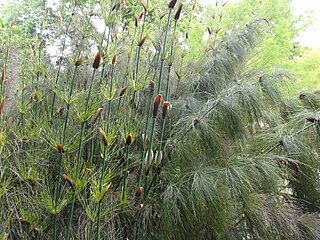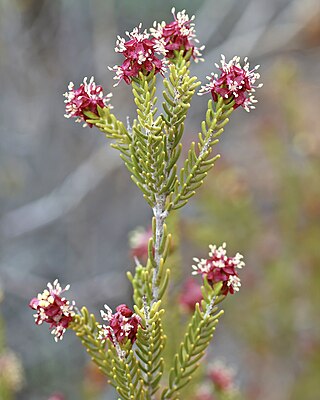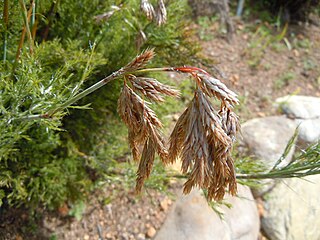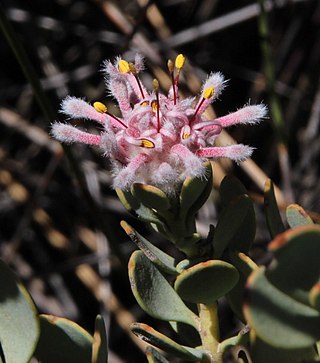
The Restionaceae, also called restiads and restios, are a family of flowering plants native to the Southern Hemisphere; they vary from a few centimeters to 3 meters in height. Following the APG IV (2016): the family now includes the former families Anarthriaceae, Centrolepidaceae and Lyginiaceae, and as such includes 51 genera with 572 known species. Based on evidence from fossil pollen, the Restionaceae likely originated more than 65 million years ago during the Late Cretaceous period, when the southern continents were still part of Gondwana.

Leucospermum is a genus of evergreen upright, sometimes creeping shrubs that is assigned to the Proteaceae, with currently forty-eight known species.

Commelina is a genus of approximately 170 species commonly called dayflowers due to the short lives of their flowers. They are less often known as widow's tears. It is by far the largest genus of its family, Commelinaceae. The Swedish taxonomist Carl Linnaeus of the 18th century named the genus after the two Dutch botanists Jan Commelijn and his nephew Caspar, each representing one of the showy petals of Commelina communis.

Passerina is a genus in the plant family Thymelaeaceae. They are ericoid bushes growing largely in fynbos and other Southern African scrub habitats.

Restio is a genus of flowering plants within the family Restionaceae, described in 1772. The entire genus is endemic to the Cape Provinces and KwaZulu-Natal in South Africa.
Plectocomiopsis is a dioecious genus of flowering plant in the palm family found in Indochina, Malaysia, Borneo and Sumatra. Hapaxanthic and armed with spines, they are a climbing rattan, closely related to the Myrialepis palms. The name is Greek for "similar to Plectocomia", another close relative.

Osyris compressa is a facultatively hemiparasitic, mainly South African plant of the sandalwood family, Santalaceae. Until recently, the favoured binomial name was Colpoon compressum, but around 2001, the genus Colpoon was included in Osyris on the basis of comparative DNA studies. That assignment is not final, however, and according to the Kew Gardens plant list, Colpoon compressum P.J.Bergius, though still in review, is the accepted name.

Vexatorella is a genus containing four species of flowering plant, commonly known as vexators, in the family Proteaceae. The genus is endemic to the Cape Floristic Region of South Africa. The name means “little trouble-maker”, given with reference to the initial difficulties of placing V. latebrosa within the family. All species are shrubs which occur in dry fynbos habitats on the fringes of the Succulent Karoo ecoregion. The inflorescences are similar to those of the related leucospermums but also share features of the leucadendrons, with the floral bracts becoming woody and enlarged following pollination. The flowers are insect-pollinated, with the seeds dispersed by ants (myrmecochory).
Anthochortus is a group of plants in the Restionaceae described as a genus in 1837. The entire genus is endemic to Cape Province in South Africa.

Ceratocaryum is a group of plants in the Restionaceae described as a genus in 1836. The entire genus is endemic to Cape Province in South Africa.

Staberoha is a group of plants in the Restionaceae described as a genus in 1841. The entire genus is endemic to Cape Province in South Africa.

Thamnochortus is a group of plants in the Restionaceae described as a genus in 1767. The entire genus is endemic to Cape Province in South Africa.

Leucospermum tomentosum is an evergreen, mostly spreading shrublet of approximately 75 cm (3 ft) high and up to 3 m (10 ft) in diameter, with alternately set, linear or narrowly spade-shaped, grey felty leaves, with one to three teeth near the tip. It has round, seated flower heads of 3–3½ cm (1.2–1.4 in) in diameter, occurring in groups of one to four, and consisting of deep yellow, very sweet scented flowers. It can survive the occasional wildfire because it regenerates from the underground rootstock. It is an endemic species that is restricted to a narrow strip along the Atlantic coast of the Western Cape province of South Africa. The species flowers between June and November. It is called Saldanha pincushion in English.

Leucospermum mundii is an evergreen, upright, rounded and richly branching shrub of ½–1 m (1½–3 ft) high that is assigned to the family Proteaceae. It has greyish, felty hairy, or hairless leaves that are broadly wedge-shaped to very broadly inverted egg-shaped, 5–8½ cm long and 2–6½ cm wide and whorl-shaped flower heads that have shades of pale yellow to crimson, of 2–4 cm (0.8–1.6 in) long and 1–2 cm (0.4–0.8 in) wide that grow in clusters of three to ten. Their long styles that emerge from the head jointly give the impression of a pincushion, with the pins upright. It is called Langeberg pincushion in English. Flowering heads can be found between July and November. It naturally occurs in fynbos in the Western Cape province of South Africa.

Vexatorella amoena, also known as the Swartruggens vexator is an evergreen shrub of up to about 1 m (3 ft) high, that is assigned to the family Proteaceae. It has entire, inverted egg-shaped, bluish grey, leathery leaves of 1½–3 cm (0.6–1.2 in) long and 5–11 mm (0.20–0.45 in) wide on a distinct stalk, and globular flower heads of about 2 cm (0.8 in) across with pale pink flowers with extended, thick-tipped styles at the tip of the branches. The plants are flowering from September to November. It is an endemic species that is restricted to the Western Cape province of South Africa.

Vexatorella obtusata is an evergreen shrub, with narrow, leathery leaves and about 2 cm big, globular flowerheads consisting of well scented, creamy pink flowers, from which a long style with a thickened tip extends. Two subspecies are distinguished, both restricted to different parts of the Western Cape province of South Africa. The creeping V. obtusata subsp. obtusata, also known as the Montagu vexator flowers from September to December, and the upright V. obtusata subsp. albomontana, also known as the Witteberg vexator, that has flowers between August and November.
Baloskion longipes, common name dense cordrush, is a dioecious perennial herb in the Restionaceae family, found in southeastern New South Wales.

Chordifex hookeri is commonly known as woolly buttonrush or cord-rush. It is a rush species of the genus Chordifex in the family Restionaceae. The species is endemic to Tasmania.

Dais is a genus of flowering plants in the family Thymelaeaceae. It is also part of the Gnidia subfamily, along with Gnidia, Drapetes, Kelleria, Pimelea, Struthiola, Lachnaea and Passerina, other genera of species). It is distributed between Tanzania to S. Africa, Madagascar. It is native to the countries of Eswatini, Lesotho, Madagascar, Malawi, Tanzania, Zimbabwe and it is also found within several Provinces of South Africa, such as Cape Provinces, Free State, KwaZulu-Natal and Northern Provinces.
















